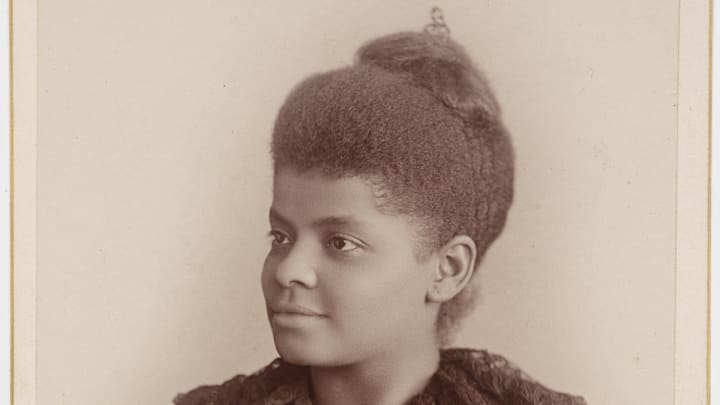To understand the power of journalism, look at the career of Ida B. Wells. Her investigations into mob lynchings in the South put the barbaric practice under national scrutiny for the first time. Even when she became the target of death threats, she never stopped fighting for gender and racial equality. Ida Wells (or Wells-Barnett) is still considered one of the most influential figures in journalism nearly a century after her death. Here are some facts you should know about the pioneering reporter.
1. Ida Wells was born into slavery.
Ida Bell Wells was born in Holly Springs, Mississippi, on July 16, 1862—one year into the Civil War. Though she wasn’t yet 2 years old when the Emancipation Proclamation freed her family, she grew up hearing stories of slavery from her parents, Lizzie and James. Her father’s background in carpentry allowed him to avoid life as a sharecropper. The Wellses got involved in politics during the Reconstruction Era and taught their children the value of education. When she was 16, Ida’s parents and younger brother died of yellow fever, leaving her in charge of her surviving younger siblings.
2. She became a teacher to support her siblings.
Though she received some higher education as a teenager, Ida was forced to put her academic career on hold. Her family was in danger of splitting up and going into foster care following the death of their parents, and she had to find work to keep everyone together. She lied about her age to get a job teaching at a local school. In 1882, she and her youngest siblings went to live with an aunt in Memphis, Tennessee, where she continued to teach and resumed her education.
3. Wells refused to give up her seat decades before Rosa Parks.

Wells’s life-long dedication to activism can be traced to a train ride she took from Memphis to Nashville in 1883. Though she had purchased a first-class ticket, she was asked to moved to the smoking car where Black passengers were expected to sit. Wells refused and was forcibly removed from the train, but not before biting the conductor. Wells successfully sued the railroad company and won $500 in damages, but the decision was quickly overturned. The experience pushed her to a career in journalism.
4. She co-owned a Memphis newspaper.
While teaching in Memphis, Wells began writing for church newspapers under the pen name Iola. Her articles targeted racist institutions—including the school board that employed her, which was segregated. With the money she saved up from her teaching position, she became part owner of the Black-run publication Memphis Free Speech and Headlight in 1889. As the paper’s editor she was given a larger platform to fight for racial equality.
5. Wells risked her life reporting lynchings.

Lynching became a personal issue for Wells when her three Black friends were targeted by a white mob in 1892. Calvin McDowell, Thomas Moss, and Henry Stewart ran a grocery store in Memphis, and their success drew ire from the white owners of competing businesses down the street. A group of white men confronted the Black entrepreneurs, leading to a violent altercation. McDowell, Moss, and Stewart were arrested and later killed when a mob broke into their jail cell to kidnap and lynch them.
Wells spent months investigating lynchings in the South following the incident, often putting herself in danger by going to the site of the killings. She published her findings in the pamphlet “Southern Horrors,” which argued that lynchings were a reaction to the threat of Black success rather than a deterrent against Black men raping white women, as was often claimed. Her 1895 book A Red Record—the first statistical report on lynching ever recorded—expanded on this thesis.
Wells also covered sexual and mob violence against Black women—a group that continues to be left out of conversations about the lynching era. She reported on female lynching victims like Eliza Woods and revealed that Black women were more likely to be raped by white men than white women were by Black men. In The Red Record, she wrote, “That chivalry which is ‘most sensitive concerning the honor of women’ can hope for little respect from the civilized world, when it confines itself entirely to women who happen to be white.”
6. Her newspaper office was vandalized.
Wells put her life at risk to report these stories. While she was away in New York City, an angry mob broke into the offices of the Memphis Free Speech and vandalized it. Her business partner fled the city and the paper was forced to shutter. Wells was rattled enough to stay in New York, but she didn’t stop covering lynchings in the South.
In addition to being a talented writer, Wells was a gifted speaker, and she launched a lecture tour that took her around the northern states and to the UK. While in Britain she established the British Anti-Lynching Society in 1894.
7. She married a fellow journalist.

In 1895, Wells married Chicago lawyer and newspaper editor Ferdinand L. Barnett and started going by Ida Wells-Barnett. She continued her journalism work as a married woman, contributing to local papers like her husband’s Chicago Conservator. She also served as secretary of the National Afro-American Council, participated in the founding of the National Association for the Advancement of Colored People (NAACP), and founded the Negro Fellowship League and the Alpha Suffrage Club in between raising her children.
8. Ida B. Wells received a posthumous Pulitzer Prize.
Ida Wells-Barnett died in 1931 at age 68, but her contributions to journalism and Black civil rights continue to be recognized today. In 2020, she was awarded a posthumous Pulitzer “for her outstanding and courageous reporting on the horrific and vicious violence against African Americans during the era of lynching.” The prize came with a $50,000 charitable donation “in support of her mission.” The exact recipient has yet to be announced.
